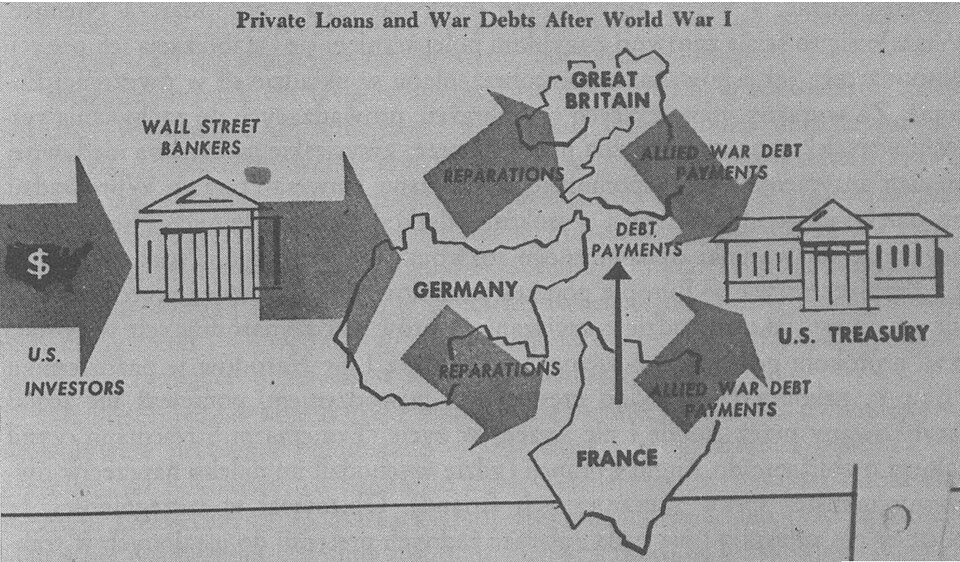OCR Specification focus:
‘Stresemann and the ‘Golden Years’; Dawes and Young Plans, economic recovery, foreign loans, political stability, improvements to working and living conditions; the impact of the Great Depression, elections and governments.’
Germany under Gustav Stresemann witnessed relative stability, international cooperation, and economic recovery, though fragility remained. These years are often called the Weimar “Golden Years.”
Stresemann’s Role and Policies
Gustav Stresemann, leader of the German People’s Party (DVP), served as Chancellor briefly in 1923 and then as Foreign Minister until 1929. His influence shaped Germany’s recovery through pragmatic compromise and diplomacy. He sought to stabilise Germany’s domestic economy and to improve international standing, recognising that only through cooperation could Germany regain strength.
Stabilising the Economy
In 1923 Germany faced hyperinflation, fuelled by passive resistance during the French occupation of the Ruhr and uncontrolled money printing. Stresemann initiated decisive measures:
Ended passive resistance in the Ruhr.
Introduced the Rentenmark, backed by industrial and agricultural assets, to replace the worthless Papiermark.
Cut government expenditure, reducing the bloated civil service workforce.
These measures restored confidence in the currency and calmed economic chaos.
Dawes Plan (1924)
The Dawes Plan represented an international attempt to restructure reparations and stabilise Germany. It was designed by American banker Charles Dawes and implemented in 1924 with Stresemann’s support.
Annual reparations payments were scaled to Germany’s capacity to pay.
US loans totalling 800 million marks were granted, providing capital for industrial investment and government spending.

This diagram illustrates the Dawes Plan’s international payment cycle: funds flowed from American banks to Germany, from Germany as reparations to Britain and France, and then back to the United States as Allied debt service. Labels are in Polish, but the arrows are straightforward and map directly onto the process described. Source
France agreed to withdraw troops from the Ruhr once payments resumed.
The Dawes Plan marked Germany’s economic dependence on the United States but also triggered growth.
Dawes Plan: A reparations settlement of 1924, introducing American loans and payment restructuring to stabilise Germany’s economy.
Although some Germans opposed the plan, claiming it chained Germany to foreign creditors, it provided short-term relief and bolstered Stresemann’s internationalist strategy.
The “Golden Years” 1924–1929
Between 1924 and 1929, Germany experienced relative prosperity and political calm, leading many historians to describe this period as the “Golden Years” of the Weimar Republic.
Economic Recovery
Industrial output recovered to pre-war levels by 1928.
Modernisation occurred in steel, chemicals, and electrical industries.
Exports and trade expanded, supported by foreign investment.
Living standards improved, with real wages increasing by around 10% between 1924 and 1930.
Housing projects provided over 2 million new homes, reducing overcrowding.

The Hufeisensiedlung (“Horseshoe Estate”) in Berlin exemplifies modernist social housing of the Weimar “Golden Years,” designed to deliver healthier, planned living environments. The horseshoe-shaped arrangement around a landscaped pond reflects the era’s emphasis on light, air, and green space. Source
Yet, dependency on foreign loans created underlying fragility.
Political Stability
Although coalition governments remained unstable, extremist parties such as the Nazis and Communists saw reduced support in elections during the mid-1920s. Moderate parties, including the Social Democrats (SPD), Centre Party, and Stresemann’s DVP, gained strength, enabling some consistency in policymaking.
Social and Cultural Change
Weimar society flourished culturally during these years:
Expansion of cinema, cabaret, and theatre.
Bauhaus movement in architecture and design.
Greater freedom for women, with increased employment and political participation.
These changes, however, provoked backlash from conservatives who perceived them as un-German and morally corrupt.
Foreign Policy Achievements
Stresemann’s diplomacy aimed at revising Versailles through negotiation rather than confrontation.
Locarno Treaties (1925): Germany accepted western borders with France and Belgium, gaining admission to the League of Nations in 1926.
Improved relations with the USA and Britain.
Secret military cooperation with the USSR under the Treaty of Rapallo (1922) continued discreetly.
This pragmatic diplomacy restored Germany’s international legitimacy while laying the groundwork for future revisions.
The Young Plan (1929)
Stresemann’s final major contribution was supporting the Young Plan, which replaced the Dawes Plan. It reduced reparations from 132 billion marks to 37 billion, payable over 59 years, and ended foreign supervision of the Reichsbank.
Young Plan: A 1929 agreement that reduced total reparations and spread payments over nearly six decades, easing the burden on Germany.
Nationalists denounced the plan as a betrayal, arguing it legitimised reparations. The Nazi Party, under Adolf Hitler, capitalised on this discontent during the “Freedom Law” referendum campaign, though the proposal to reject reparations outright was defeated.
The Impact of the Great Depression
The apparent stability of the Golden Years collapsed with the Wall Street Crash of 1929. American loans and investment, the cornerstone of recovery, were suddenly withdrawn.
Consequences for Germany
Industrial output fell sharply after 1929.
Unemployment soared, reaching over 6 million by 1932.
Banking crisis emerged, with widespread closures and credit shortages.
The welfare system, burdened by mass unemployment, collapsed under strain.
This economic disaster fuelled political extremism, with voters abandoning moderate parties and turning to the Nazis and Communists, who promised radical solutions.
Elections and Governments 1928–1932
In the 1928 Reichstag elections, the SPD emerged as the largest party, while the Nazis won just 2.6% of the vote. However, the Depression transformed the political landscape:
By 1930, the Nazi Party surged to 18.3%.
Coalition governments failed to cooperate, leading to reliance on presidential decrees under Article 48.
Chancellors Brüning, Papen, and Schleicher governed weakly, paving the way for Hitler’s appointment in 1933.
Thus, the gains of Stresemann’s era were quickly undone by the global crisis.
FAQ
Stresemann recognised that Germany lacked the military and economic strength to directly overturn Versailles. Instead, he aimed to restore Germany’s power through gradual revision.
By improving relations with Britain, France, and the USA, he sought to win concessions that weakened Versailles over time. His approach reassured foreign investors and helped secure the loans essential to recovery.
Many nationalists believed the Dawes Plan entrenched the humiliation of Versailles. They argued it kept Germany dependent on foreign powers and legitimised reparations.
Key points of criticism included:
Ongoing acceptance of reparations as an obligation.
Reliance on US finance, leaving Germany vulnerable to external crises.
The perception that Stresemann was “selling out” national sovereignty for short-term gain.
Stresemann often presented his policies differently to domestic and international audiences. Abroad, he emphasised cooperation; at home, he reassured critics that his concessions were tactical.
He described his strategy as “fulfilment,” claiming that meeting obligations would ultimately expose their impossibility and force revision. This careful balancing act helped maintain fragile support across Germany’s divided political spectrum.
The 1920s saw Berlin become a centre of modernist culture, boosting the perception of progress and optimism.
The Bauhaus school encouraged new approaches to design and architecture.
Theatre and cinema, including films by directors such as Fritz Lang, reached international acclaim.
Women’s visibility in employment and fashion symbolised change, even if these gains were uneven.
These cultural shifts contributed to the idea of a flourishing, modern Germany, though they also fuelled conservative backlash.
By 1929, nationalist groups were more organised and hostile to any agreement tied to reparations. They saw the Young Plan’s long-term payment schedule as chaining future generations to Versailles.
The campaign against it, including Hitler’s involvement in the “Freedom Law” petition, mobilised widespread opposition. Although the referendum failed, it provided a platform for Nazi propaganda, showing how economic diplomacy could be politically destabilising at home.
Practice Questions
Question 1 (2 marks)
In which year was the Dawes Plan introduced, and what was its main purpose?
Mark Scheme
1 mark for correctly identifying the year as 1924.
1 mark for explaining the purpose as restructuring reparations and stabilising Germany’s economy through foreign loans (or equivalent wording).
Question 2 (6 marks)
Explain two ways in which Stresemann’s policies contributed to the stability of the Weimar Republic during the so-called “Golden Years.”
Mark Scheme
Award up to 3 marks for each valid explanation, maximum 6 marks in total.
Economic stabilisation (up to 3 marks):
1 mark for identifying Stresemann’s introduction of the Rentenmark.
1 mark for linking this to tackling hyperinflation.
1 mark for explaining that this restored confidence and encouraged recovery.
Dawes Plan and foreign loans (up to 3 marks):
1 mark for identifying the Dawes Plan of 1924.
1 mark for noting the role of American loans in fuelling recovery.
1 mark for linking this to improvements in industry, living standards, or political stability.
Foreign policy/diplomatic success (alternative valid explanation, up to 3 marks):
1 mark for identifying the Locarno Treaties or League of Nations membership.
1 mark for explaining how this improved international standing.
1 mark for linking this to increased confidence in the Weimar Republic.
Maximum 6 marks: candidates can achieve full credit with any two developed explanations.

